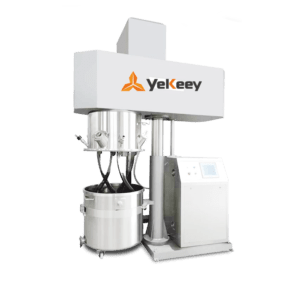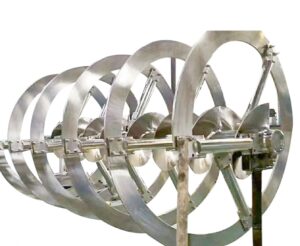-
what is the difference between industrial planetary mixer and spiral mixer?
There are some differences between industrial planetary mixers and spiral mixers, mainly manifested in the following aspects:
(1) Working principle:
- Industrial Planetary mixer: Its stirring blade rotates around the axis of the mixing tank in a planetary motion, while performing revolution and rotation, forming strong shear, kneading, and flow effects, ensuring efficient mixing of materials.
- Spiral mixer: The material is pushed from the bottom of the mixer to the top through spiral shaped mixing blades, and then returned to the bottom from the top to form a continuous spiral motion, allowing the material to mix during the mixing process.
(2) Structure and Design:
- Industrial Planetary mixer: usually equipped with a multi-layer blade mixer and an automatic scraper to ensure that the material can fully participate in the mixing process and avoid dead corners and residues.
- Spiral mixer: mainly composed of spiral shaped mixing blades and mixing tanks, with a relatively simple structure.
(3) Mixing effect:
- Industrial Planetary mixer: Due to its unique planetary motion and composite stirring effect, it can achieve more efficient mixing and more uniform material distribution.
- Spiral mixer: Although it can also achieve material mixing, the mixing effect may not be as uniform as planetary mixer, and it is more suitable for certain specific materials and process requirements.
(4) Application field:
- Planetary mixer: widely used in chemical, pharmaceutical, food, new energy and other fields, especially suitable for mixing high viscosity and high solid content materials.
- Spiral mixer: usually used for mixing powdered, granular, and semi fluid materials, especially widely used in industries such as flour, feed, and chemical industry.
2. Which is better industrial planetary mixer or spiral mixer?
Planetary Mixers and Spiral Mixers each have their own advantages and disadvantages, and which one is better depends on your application needs and preferences.
- A planetary mixer is an efficient and fast mixing device, whose planetary motion trajectory causes strong shearing, squeezing, and flipping effects on the material during the mixing process, thereby achieving fast and uniform mixing. This type of mixer is suitable for processing various powdered, granular, and viscous materials, especially suitable for situations that require high shear strength and high mixing strength, such as pharmaceutical, chemical, food and other industries. The advantages of planetary mixer are good mixing effect, fast speed, and simple operation, but the disadvantages are high noise and high maintenance cost.
- A spiral mixer is a mixing equipment suitable for handling materials with poor fluidity and easy agglomeration. Its spiral stirring blades can push the material upwards from the bottom, while forming vortices in the barrel to achieve mixing. The advantages of a spiral mixer are uniform mixing, minimal material damage, easy cleaning and maintenance, but the disadvantages are slow mixing speed and unsuitable for mixing high viscosity materials.
Therefore, choosing between a planetary mixer or a spiral mixer depends on your specific needs.
- If you need to mix various materials quickly and efficiently, and are not particularly sensitive to noise and maintenance costs, then planetary mixers may be more suitable for you;
- If you need to handle materials with poor fluidity and easy clumping, and do not have special requirements for mixing speed, a spiral mixer may be more suitable for you.
- At the same time, you also need to consider factors such as equipment price, space, energy consumption, operation and maintenance,etc., in order to choose the most suitable mixing equipment for you.
3. What is the difference between a rotary mixer and industrial planetary mixer?
The main differences between a Rotary Mixer and a Planetary Mixer are reflected in the following aspects:
(1) Working principle:
- Rotary mixer: This type of mixer mainly relies on the rotational motion of the rotating cylinder to mix materials. The material is subjected to centrifugal force and gravity inside the cylinder, achieving convection and rolling between materials and achieving the purpose of mixing.
- Planetary Mixer: Planetary mixers mix materials through the planetary motion of the agitator blades (both rotating and orbiting). This type of movement can generate strong shear, kneading, and flow effects, ensuring that the material is fully mixed during the mixing process.
(2) Structure design:
- Rotary mixer: mainly composed of a rotary cylinder, a driving device, and a supporting structure, with a relatively simple structure.
- Planetary mixer: includes mixing tank, mixing blade, transmission device, etc. Its structure is more complex, but it can achieve more efficient mixing.
(3) Mixing effect:
- Rotary mixer: suitable for mixing general materials, but its mixing effect may be limited for materials with high viscosity, high solid content, or difficult to mix.
- Planetary mixer: Due to its unique planetary motion and strong shear and kneading effects, planetary mixers are usually able to achieve more efficient mixing effects, especially suitable for handling materials with high viscosity, high solid content, or difficult to mix.
(4) Application field:
- Rotary mixer widely used in chemical, food, metallurgy and other fields, mainly for mixing general materials.
- Planetary mixers are more commonly used in situations that require efficient mixing, such as chemical, pharmaceutical, food, new energy, etc. They are particularly suitable for handling materials with high viscosity, high solid content, or difficult to mix.









I was just talking about this the other day. So glad I stumbled upon your post.
Usually I do not read article on blogs however I would like to say that this writeup very compelled me to take a look at and do so Your writing taste has been amazed me Thanks quite nice post
Wow, I never considered this angle before. Thanks for enlightening me.